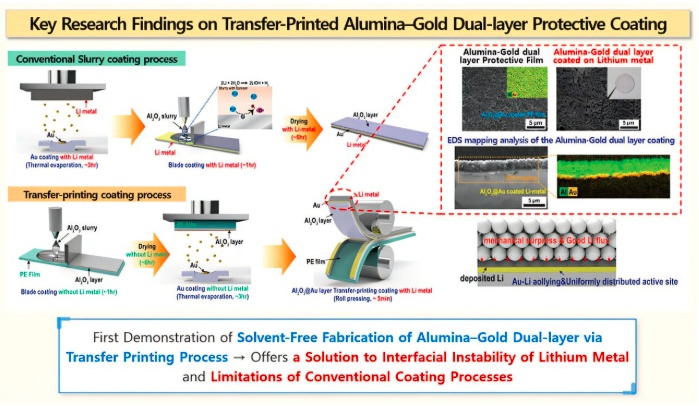KRICT Develops New Transfer Method to Create Safer, Longer-Lasting Lithium Metal Batteries
According to foreign media reports, a research team from the National Research Council of Science and Technology of Korea has developed a breakthrough transfer technology that can form a thin protective layer on the surface of lithium metal. This innovation is expected to solve the long-standing dendrite problem that has plagued next-generation lithium metal batteries.

Image Source: KRICT
Dr. Jungdon Suk's team at the Advanced Battery Research Center of the Korea Research Institute of Chemical Technology (KRICT) successfully transferred a hybrid protective layer composed of solid polymer and ceramic onto lithium metal using a solvent-free process. The related research paper was published in the journal Energy Storage Materials.
Unlike traditional wet coating methods, this technology can achieve uniform coating over large areas without damaging the surface of active lithium, marking a significant step toward commercial viability.
Lithium metal batteries are the next generation of energy storage systems, using lithium metal instead of graphite as the anode. The theoretical capacity of lithium metal anodes is ten times that of conventional lithium-ion batteries and is a key material for high-energy-density solid-state batteries and lithium-sulfur batteries.
However, the risk of dendrite formation during charge-discharge cycles poses safety hazards, including the risks of short circuits and fires, and also limits battery lifespan. In addition, traditional wet coating processes rely on organic solvents, which can introduce impurities and cause surface damage, making large-scale production and commercialization more complex.
To overcome these challenges, the research team developed two types of protective layers: a bilayer consisting of aluminum oxide (Al₂O₃) and gold (Au), and a hybrid layer composed of ceramic (Al-LLZO) and polymer components. Subsequently, the researchers used roll-to-roll transfer technology to laminate these protective layers onto lithium metal, marking the first demonstration of this method in the field.
The technology forms a protective layer on a separate substrate and then transfers it onto lithium using pressure, without the use of solvents, minimizing lithium damage while improving uniformity and process repeatability.
In early studies, the Al2O3-Au bilayer structure effectively suppressed dendrite growth and maintained stable cycling performance by leveraging mechanical strength and reduced interfacial resistance. This research was the first to introduce transfer printing technology to address interfacial instability and the limitations of wet coating methods.
On this basis, the research team has now demonstrated a method for transferring an ion-conductive flexible hybrid protective layer over an area of 245 × 50 mm, with the protective layer having a thickness of only 5 micrometers.
These mixed layers inhibit dendrite growth and induce uniform lithium-ion flux at the electrode-electrolyte interface, thereby achieving stable cycling performance. The uniform transfer of large-area protective films not only confirms the advanced nature of the technology but also demonstrates its scalability for commercialization.
In the soft-pack battery test, the mixed protection lithium anode retained 81.5% of its capacity after 100 charge-discharge cycles, with an overpotential as low as 55.34 mV and a coulombic efficiency of up to 99.1%, making its stability more than twice that of bare lithium batteries. Even under high-rate conditions with complete discharge in 9 minutes, the battery was able to maintain 74.1% of its initial capacity, demonstrating fast, stable, and efficient cycling characteristics.
The team expects that this innovation will accelerate the practical application of lithium metal batteries in high-energy applications such as electric vehicles and energy storage systems (ESS). Additionally, the technology is anticipated to extend to solid-state batteries and lithium-sulfur batteries, further advancing next-generation battery platforms.
Dr. Suk stated, "This study combines novel protective materials with a scalable transfer process, overcoming key challenges such as interfacial instability in lithium metal batteries and the limitations of wet processing."
Dr. Young-Kuk Lee, Director of KRICT, added, "This is one of the most practical solutions to achieve high energy density lithium metal batteries, which is expected to enhance Korea's competitiveness in the global battery industry."
【Copyright and Disclaimer】The above information is collected and organized by PlastMatch. The copyright belongs to the original author. This article is reprinted for the purpose of providing more information, and it does not imply that PlastMatch endorses the views expressed in the article or guarantees its accuracy. If there are any errors in the source attribution or if your legitimate rights have been infringed, please contact us, and we will promptly correct or remove the content. If other media, websites, or individuals use the aforementioned content, they must clearly indicate the original source and origin of the work and assume legal responsibility on their own.
Most Popular
-

List Released! Mexico Announces 50% Tariff On 1,371 China Product Categories
-

Nissan Cuts Production of New Leaf EV in Half Due to Battery Shortage
-

New Breakthrough in Domestic Adiponitrile! Observing the Rise of China's Nylon Industry Chain from Tianchen Qixiang's Production
-

Dow, Wanhua, Huntsman Intensively Raise Prices! Who Controls the Global MDI Prices?
-

Mexico officially imposes tariffs on 1,400 chinese products, with rates up to 50%






